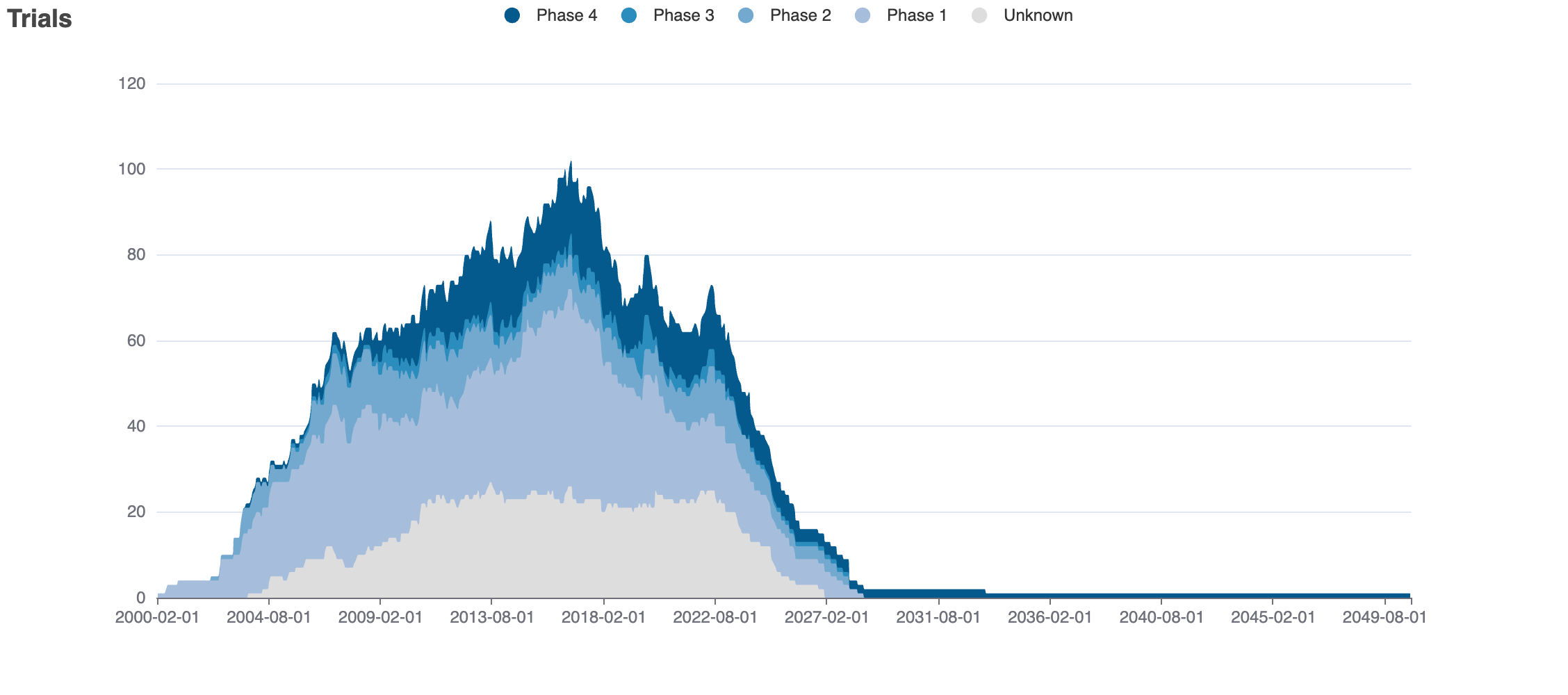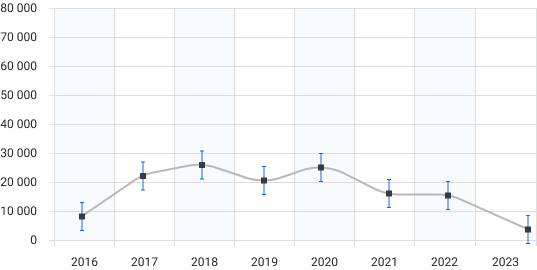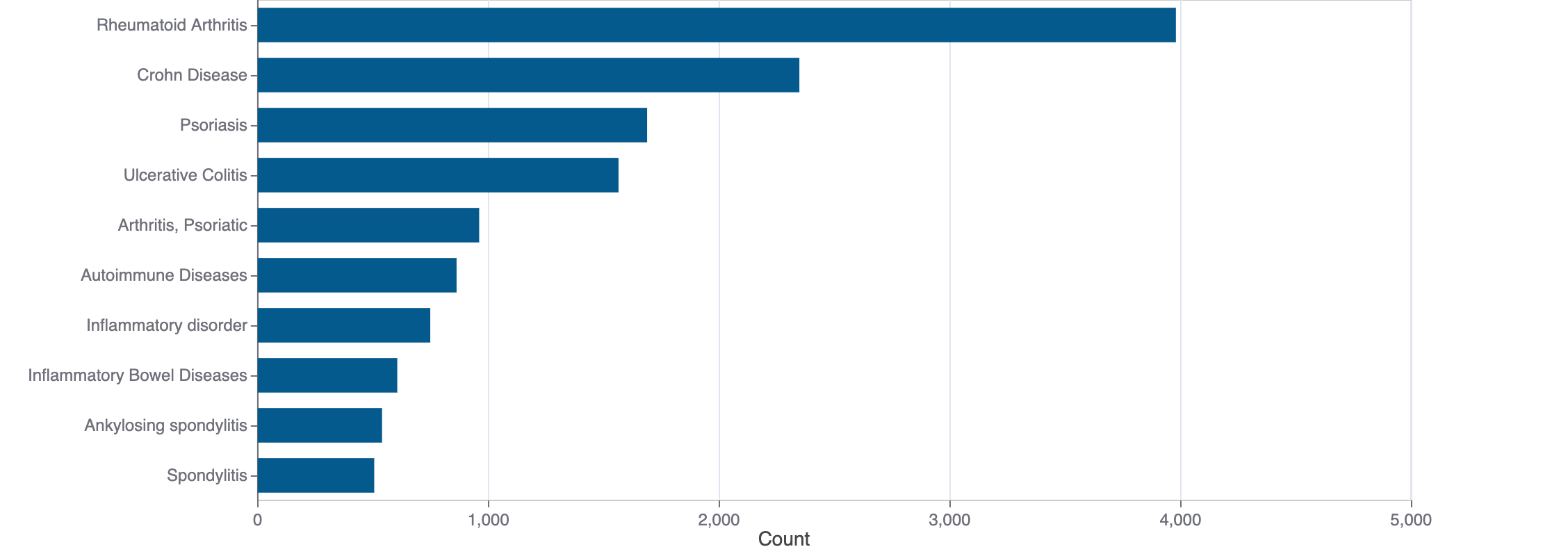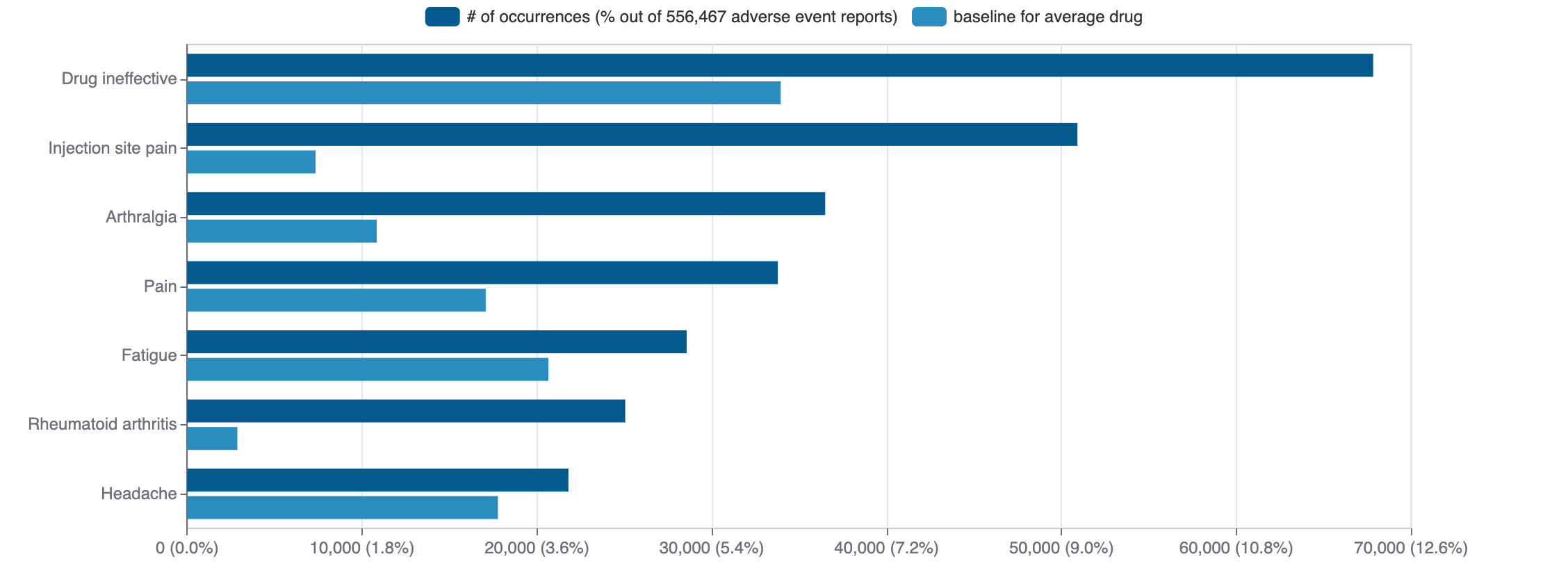Methamphetamine
Desoxyn, Methamphetamine (methamphetamine) is a small molecule pharmaceutical. Methamphetamine was first approved as Desoxyn on 1982-01-01. It is used to treat attention deficit disorder with hyperactivity, narcolepsy, and obesity in the USA.
Download report
Favorite
Events Timeline
Commercial
Clinical
Drug
Target
Variants
Financial
Trends
Safety
Events Timeline
5D
1M
3M
6M
YTD
1Y
2Y
5Y
Max
Events
FDA approval date
EMA approval date
Patent expiration date
Study first post date
Last update post date
Start date
Primary completion date
Completion date
Results first post date

Mock data
Subscribe for the real data
Subscribe for the real data
Commercial
Therapeutic Areas
Trade Name
FDA
EMA
Desoxyn, Methamphetamine (discontinued: Desoxyn, Methampex, Methamphetamine)
Drug Products
FDA
EMA
New Drug Application (NDA)
New Drug Application (NDA)
Abbreviated New Drug Application (ANDA)
Abbreviated New Drug Application (ANDA)
Methamphetamine hydrochloride
Tradename | Company | Number | Date | Products |
|---|---|---|---|---|
| DESOXYN | Key Therapeutics | N-005378 RX | 1982-01-01 | 1 products, RLD, RS |
Show 1 discontinued
Labels
FDA
EMA
Brand Name | Status | Last Update |
|---|---|---|
| methamphetamine hydrochloride | ANDA | 2024-12-10 |
Indications
FDA
EMA
Agency Specific
FDA
EMA
No data
Patent Expiration
No data
HCPCS
No data
Clinical
Clinical Trials
258 clinical trials
View more details

Mock data
Subscribe for the real data
Subscribe for the real data
Indications Phases 4
Indication | MeSH | Ontology | ICD-10 | Ph 1 | Ph 2 | Ph 3 | Ph 4 | Other | Total |
|---|---|---|---|---|---|---|---|---|---|
| Substance-related disorders | D019966 | EFO_0003890 | F13 | 15 | 21 | 4 | 3 | 25 | 63 |
| Hiv infections | D015658 | EFO_0000764 | B20 | 1 | 8 | — | 2 | 10 | 20 |
| Depression | D003863 | — | F33.9 | 1 | — | 1 | 3 | 3 | 8 |
| Mental disorders | D001523 | EFO_0000677 | F91.9 | 1 | — | — | 3 | 2 | 6 |
| Psychotic disorders | D011618 | — | F20.81 | — | — | — | 2 | 2 | 4 |
| Recurrence | D012008 | — | — | — | 1 | — | 1 | 1 | 3 |
| Dual (psychiatry) diagnosis | D017831 | — | — | — | — | — | 2 | 1 | 3 |
| Hyperkinesis | D006948 | — | — | — | — | — | 1 | 1 | 2 |
| Attention deficit disorder with hyperactivity | D001289 | EFO_0003888 | F90 | — | — | — | 1 | 1 | 2 |
| Inflammation | D007249 | MP_0001845 | — | — | — | — | 1 | 1 | 2 |
Show 8 more
Indications Phases 3
Indication | MeSH | Ontology | ICD-10 | Ph 1 | Ph 2 | Ph 3 | Ph 4 | Other | Total |
|---|---|---|---|---|---|---|---|---|---|
| Drug overdose | D062787 | — | — | — | 2 | 1 | — | 1 | 3 |
| Anxiety | D001007 | EFO_0005230 | F41.1 | — | 1 | 1 | — | — | 2 |
| Anxiety disorders | D001008 | EFO_0006788 | F41.1 | — | — | 1 | — | — | 1 |
Indications Phases 2
Indication | MeSH | Ontology | ICD-10 | Ph 1 | Ph 2 | Ph 3 | Ph 4 | Other | Total |
|---|---|---|---|---|---|---|---|---|---|
| Amphetamine-related disorders | D019969 | EFO_0004701 | F15 | 10 | 13 | — | — | 14 | 35 |
| Addictive behavior | D016739 | EFO_0004347 | — | 4 | 6 | — | — | 9 | 19 |
| Hiv | D006678 | — | O98.7 | 2 | 4 | — | — | 9 | 13 |
| Acquired immunodeficiency syndrome | D000163 | EFO_0000765 | B20 | 1 | 1 | — | — | 4 | 5 |
| Opioid-related disorders | D009293 | EFO_0005611 | F11 | — | 1 | — | — | 4 | 5 |
| Sexually transmitted diseases | D012749 | — | A50-A64 | 1 | 2 | — | — | 1 | 4 |
| Alcoholism | D000437 | EFO_0003829 | F10.1 | — | 2 | — | — | 1 | 3 |
| Hiv seropositivity | D006679 | — | — | — | 1 | — | — | 1 | 2 |
| Obesity | D009765 | EFO_0001073 | E66.9 | — | 1 | — | — | 1 | 2 |
| Alcohol drinking | D000428 | EFO_0004329 | — | — | 1 | — | — | 1 | 2 |
Show 7 more
Indications Phases 1
Indication | MeSH | Ontology | ICD-10 | Ph 1 | Ph 2 | Ph 3 | Ph 4 | Other | Total |
|---|---|---|---|---|---|---|---|---|---|
| Healthy volunteers/patients | — | — | — | 4 | — | — | — | 2 | 6 |
| Cognition | D003071 | EFO_0003925 | — | 1 | — | — | — | — | 1 |
| Cardiovascular abnormalities | D018376 | EFO_0003848 | — | 1 | — | — | — | — | 1 |
| Drug interactions | D004347 | — | — | 1 | — | — | — | — | 1 |
| Homosexuality | D006716 | — | — | 1 | — | — | — | — | 1 |
| Affect | D000339 | — | — | 1 | — | — | — | — | 1 |
| Sexual abstinence | D012746 | — | — | 1 | — | — | — | — | 1 |
| Chemically-induced disorders | D064419 | — | — | 1 | — | — | — | — | 1 |
| Motivation | D009042 | — | — | 1 | — | — | — | — | 1 |
| Social behavior | D012919 | — | STY/T054 | 1 | — | — | — | — | 1 |
Indications Without Phase
Indication | MeSH | Ontology | ICD-10 | Ph 1 | Ph 2 | Ph 3 | Ph 4 | Other | Total |
|---|---|---|---|---|---|---|---|---|---|
| Cocaine-related disorders | D019970 | — | F14 | — | — | — | — | 4 | 4 |
| Medication adherence | D055118 | EFO_0006344 | — | — | — | — | — | 3 | 3 |
| Pulmonary hypertension | D006976 | EFO_0001361 | I27.20 | — | — | — | — | 2 | 2 |
| Recreational drug use | D000084783 | — | — | — | — | — | — | 2 | 2 |
| Dental caries | D003731 | EFO_0003819 | K02 | — | — | — | — | 2 | 2 |
| Craving | D066249 | — | — | — | — | — | — | 2 | 2 |
| Heart failure | D006333 | EFO_0003144 | I50 | — | — | — | — | 2 | 2 |
| Pulmonary arterial hypertension | D000081029 | — | — | — | — | — | — | 1 | 1 |
| Familial primary pulmonary hypertension | D065627 | — | I27.0 | — | — | — | — | 1 | 1 |
| Humans | D006801 | — | STY/T016 | — | — | — | — | 1 | 1 |
Show 19 more
Epidemiology
Epidemiological information for investigational and approved indications
View more details
Drug
General
| Drug common name | Methamphetamine |
| INN | metamfetamine |
| Description | Methamphetamine[note 1] (contracted from N-methylamphetamine) is a potent central nervous system (CNS) stimulant that is mainly used as a recreational drug and less commonly as a second-line treatment for attention deficit hyperactivity disorder and obesity. Methamphetamine was discovered in 1893 and exists as two enantiomers: levo-methamphetamine and dextro-methamphetamine.[note 2] Methamphetamine properly refers to a specific chemical substance, the racemic free base, which is an equal mixture of levomethamphetamine and dextromethamphetamine in their pure amine forms, but the hydrochloride salt, commonly called crystal meth, is widely used. Methamphetamine is rarely prescribed over concerns involving human neurotoxicity and potential for recreational use as an aphrodisiac and euphoriant, among other concerns, as well as the availability of safer substitute drugs with comparable treatment efficacy such as Adderall and Vyvanse. Dextromethamphetamine is a stronger CNS stimulant than levomethamphetamine.
|
| Classification | Small molecule |
| Drug class | — |
| Image (chem structure or protein) |  |
| Structure (InChI/SMILES or Protein Sequence) | CN[C@@H](C)Cc1ccccc1 |
Identifiers
| PDB | — |
| CAS-ID | 537-46-2 |
| RxCUI | — |
| ChEMBL ID | CHEMBL1201201 |
| ChEBI ID | 6809 |
| PubChem CID | 1206 |
| DrugBank | DB01577 |
| UNII ID | 44RAL3456C (ChemIDplus, GSRS) |
Target
No data
Variants
No data
Financial
Revenue by drug
$
€
£
₣
No data
Estimated US medical usage
Methamphetamine
Total medical expenditures per year (USD, in millions)

Mock data
Subscribe for the real data
Subscribe for the real data
Number of persons purchased

Mock data
Subscribe for the real data
Subscribe for the real data
Number of purchases

Mock data
Subscribe for the real data
Subscribe for the real data
Refill frequency

Mock data
Subscribe for the real data
Subscribe for the real data
Price per prescription (USD)

Mock data
Subscribe for the real data
Subscribe for the real data
Tabular view
Trends
PubMed Central
Top Terms for Disease or Syndrome:

Mock data
Subscribe for the real data
Subscribe for the real data
Additional graphs summarizing 46,195 documents
View more details
Safety
Black-box Warning
No Black-box warning
Adverse Events
Top Adverse Reactions

Mock data
Subscribe for the real data
Subscribe for the real data
10,517 adverse events reported
View more details
© 2020-2025 Collaborative Drug Discovery Inc. (CDD) | Terms of Use